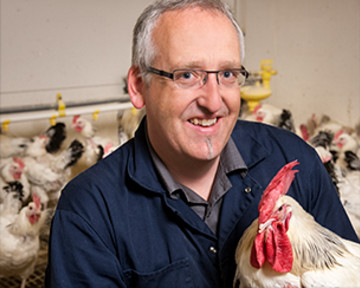Precision feeding chickens for a uniform flock

The world’s first system that instantly measures a chicken’s weight and its exact feed need is returning information about cage-free chickens at a level of detail never before achieved.
Designed by poultry researcher Martin Zuidhof, the Precision Broiler Breeder Feeding System has been run through four pilot tests and four full experiments at the Edmonton Research Station on the University of Alberta South Campus since 2013.
Over- and underweight chickens produce fewer chicks, said Zuidhof, so feed restriction to achieve a predetermined target body weight has become standard industry practice for feeding broiler breeders. “However, competition for feed results in poor flock uniformity,” he said.
Helping birds meet their target weight
His precision feeding system allows each free-run bird to enter a feeding station and perch on a platform that weighs the chicken. Using a radio frequency identifier on the bird’s wing, the system recalls such information as the bird’s target weight and when it last fed. If a bird weighs less than its target weight, it dispenses a small amount of feed. If there’s no need for the bird to eat at that moment, the chicken is gently removed from the station.
Zuidhof and his team have perfected flock uniformity by successfully feeding free-run birds exactly what they need to grow to a target weight. Although researchers were hoping that precision feeding would increase chick production from each hen by 10%, some changes in management are still needed for this to be realised.
Change to metabolism
“Feeding multiple meals per day appears to alter the birds’ metabolism in a manner that makes the industry standard target body weights too low for some hens to become sexually mature,” said Zuidhof.
“The most likely solution will be an increase in the amount breeders are fed. Such a change would be welcome, because the degree of feed restriction recommended for optimal chick production from broiler breeders has been criticised for welfare reasons.”
Labour savings
As well as monitoring and dispensing individual feeding exactly, the system creates labour savings for the producer who does not have to weigh each bird individually or feed the males and females separately.
Such a system has not been viable before now, because the technology cost per animal unit did not make sense for poultry. Zuidhof said he was able to overcome this obstacle because of the decreasing cost of technology, an increasing sense of urgency around broiler-breeder management issues and a diverse pool of funding.
Future plans
In addition to perfecting the appropriate body weight targets or level of feed intake to ensure that birds receive the nutritional and metabolic cues required to begin laying eggs, Zuidhof’s next plans are to improve the training protocols to ensure that no birds are left behind by the system, and then test it in a commercial setting. “I hope to do that within the next three to five years,” he said.
Zuidhof’s research has been supported by the Alberta Livestock and Meat Agency (ALMA), Alberta Innovates-Bio Solutions, the Agriculture and Food Council of Alberta, the Canadian Hatching Egg Producers, Alberta Hatching Egg Producers, DuPont, the Poultry Industry Council, Alberta Chicken Producers, Canadian Poultry Research Council, Cobb-Vantress Inc., and Aviagen Broiler Breeders.












